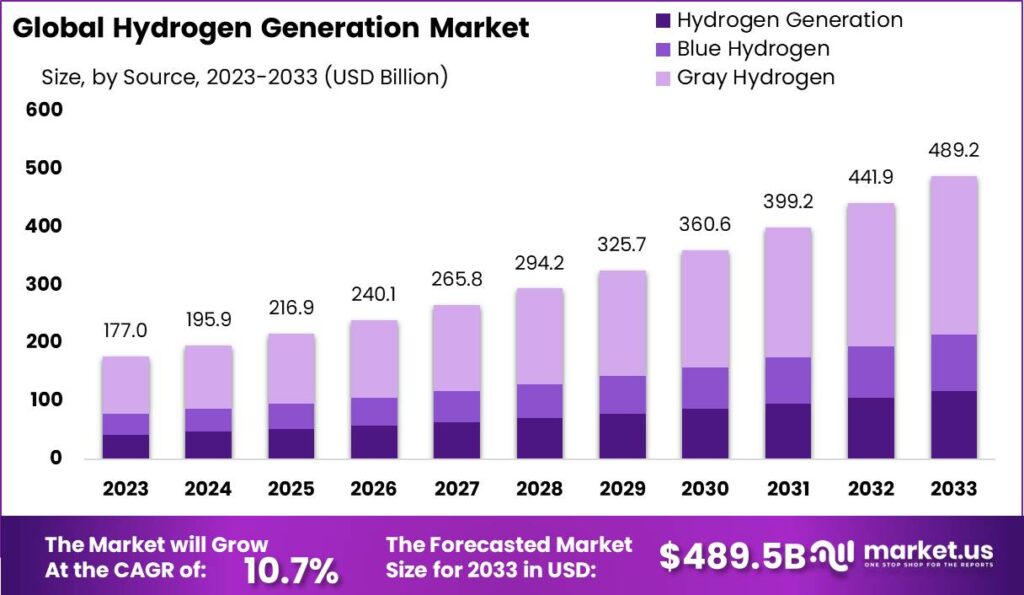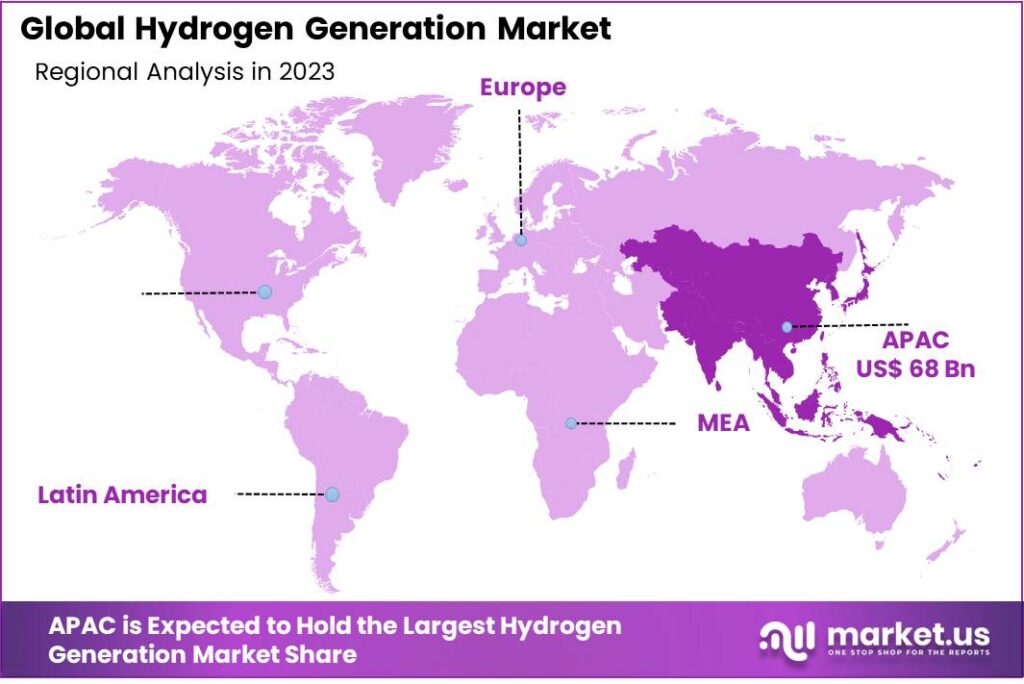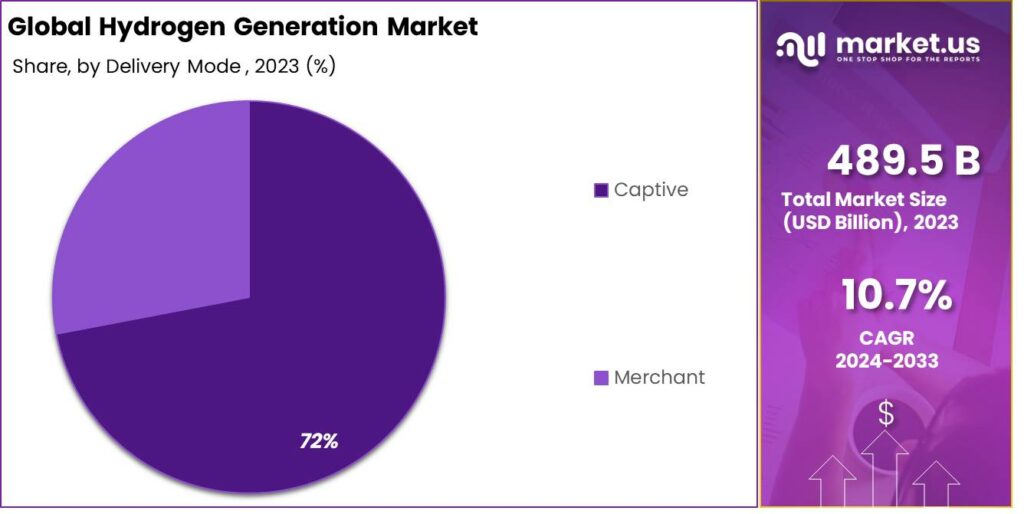New York, Jan. 09, 2024 (GLOBE NEWSWIRE) -- According to market.us, the Hydrogen Generation Market reached USD 177.0 billion in 2023 and is projected to witness substantial growth, reaching approximately USD 489.2 billion by 2033. From 2024 to 2033, this market is anticipated to experience its highest compound annual growth rate (CAGR) at 10.7%.
The hydrogen generation market refers to the industry involved in the production, storage, and distribution of hydrogen gas. Hydrogen is a versatile energy carrier that can be produced through various methods, including electrolysis, steam methane reforming, biomass gasification, and other emerging technologies like solar and wind-powered electrolysis. This market encompasses a range of technologies, infrastructure development, and applications for hydrogen in sectors such as transportation, industrial processes, power generation, and more.
The demand for hydrogen has been increasing due to its potential as a clean energy source, particularly in reducing greenhouse gas emissions when used in fuel cells or as a feedstock in industrial processes. The market involves companies specializing in hydrogen production, storage, transportation, and the development of fuel cell technologies, along with government initiatives and policies supporting the adoption of hydrogen as a sustainable energy solution.

Sample Report Request: Unlock Valuable Insights for Your Business: https://market.us/report/hydrogen-generation-market/request-sample
Key Takeaway:
- Market Size and Growth: Expected to reach USD 489.2 billion by 2033, with a consistent 10.7% CAGR from 2023 to 2033. In 2023 alone, it’s forecasted to total USD 177.0 billion.
- Source Breakdown: Gray Hydrogen leads with 56% market share in 2023 due to lower production costs. However, Green Hydrogen, produced via electrolysis using renewable energy, is gaining traction for its environmental sustainability.
- Dominant Processes: Steam Methane Reforming (SMR) is the primary method, known for efficiency and scalability. Electrolysis, a green method, is also growing in popularity.
- Delivery Modes: Captive holds over 72% market share, catering to high-demand industries. Merchant, distributing to various sectors, suits fluctuating demand industries.
- Major Applications: Chemical Processing dominates due to hydrogen’s role as a fuelstock. Transportation, Petroleum Recovery, and Power Generation are also significant sectors.
- Driving Factors: The global shift towards cleaner energy, government policies, the emerging hydrogen economy, and rising demand in transportation are key growth drivers.
- Challenges: High production costs, infrastructure development needs, energy efficiency improvements, and hydrogen storage/transportation issues are challenges hindering growth.
- Growth Opportunities: Renewable hydrogen production, expanding industrial applications, hydrogen mobility, and hydrogen export to regions with high energy demand.
- Key Trends: Growing focus on Green Hydrogen, hydrogen blending with natural gas, hydrogen mobility projects, and global alliances for hydrogen production and trade.
- Regional Dynamics: Asia-Pacific (APAC) dominates due to significant investments, renewable energy resources, and rapid industrialization. North America and Europe are also prominent markets.
- Key Players: Major companies like Air Liquide International S.A., Linde Plc, and Air Products and Chemicals Inc. play vital roles in the market.
Factors are contributing to the growth and revolution of the Hydrogen Generation Market in the Chemicals and Materials industry
- Demand for Clean Energy: Hydrogen is gaining traction as a clean energy source, especially in sectors where decarbonization is a priority. Industries are seeking alternatives to fossil fuels, and hydrogen is seen as a promising option due to its potential to produce energy with zero emissions.
- Government Initiatives and Policies: Many governments worldwide are investing in hydrogen as part of their climate change mitigation strategies. Subsidies, tax incentives, and policy frameworks supporting the development and use of hydrogen in various industries are fostering market growth.
- Technological Advancements: Ongoing research and technological innovations are improving the efficiency and cost-effectiveness of hydrogen generation methods. Advancements in electrolysis, catalysts, and renewable energy integration are making hydrogen production more viable.
- Rising Environmental Concerns: The focus on reducing carbon footprints is pushing industries to explore cleaner alternatives. Hydrogen's potential to be produced from renewable sources and used without emitting greenhouse gases positions it as a key solution in combating climate change.
- Growing Industrial Applications: Hydrogen finds applications in various industries within the Chemicals and Materials sector, including refining, ammonia production, methanol production, and other chemical processes. The demand for hydrogen as a feedstock for these processes contributes to market growth.
Get deeper insights into the market size, current market scenario, future growth opportunities, major growth driving factors, the latest trends, and much more. Buy the full report here
Top Trends in the Global Hydrogen Generation Market
- Demand for Clean Energy: Hydrogen is gaining traction as a clean energy source, especially in sectors where decarbonization is a priority. Industries are seeking alternatives to fossil fuels, and hydrogen is seen as a promising option due to its potential to produce energy with zero emissions.
- Government Initiatives and Policies: Many governments worldwide are investing in hydrogen as part of their climate change mitigation strategies. Subsidies, tax incentives, and policy frameworks supporting the development and use of hydrogen in various industries are fostering market growth.
- Technological Advancements: Ongoing research and technological innovations are improving the efficiency and cost-effectiveness of hydrogen generation methods. Advancements in electrolysis, catalysts, and renewable energy integration are making hydrogen production more viable.
- Rising Environmental Concerns: The focus on reducing carbon footprints is pushing industries to explore cleaner alternatives. Hydrogen's potential to be produced from renewable sources and used without emitting greenhouse gases positions it as a key solution in combating climate change.
- Growing Industrial Applications: Hydrogen finds applications in various industries within the Chemicals and Materials sector, including refining, ammonia production, methanol production, and other chemical processes. The demand for hydrogen as a feedstock for these processes contributes to market growth.
Regional Analysis
The Hydrogen Generation Market has seen distinctive regional dynamics, particularly in Asia-Pacific (APAC), which has emerged as the dominant player, capturing over 38% of the market share in 2023. The demand for hydrogen generation in the APAC region was valued at USD 68 billion in 2023, a substantial figure that highlights the region's significant involvement in the industry.
This ascendancy can be attributed to various factors: APAC countries like China and Japan have made substantial investments in promoting hydrogen as a clean energy solution. These nations have also invested in hydrogen infrastructure and technology. Moreover, the region benefits from abundant renewable energy resources, making green hydrogen production economically viable.
The rapid industrialization and urbanization in APAC have significantly fueled the demand for hydrogen across various sectors like transportation and power generation. This regional dominance underscores the critical role that Asia-Pacific plays in the landscape of hydrogen generation.

Gain expert insights and supercharge your growth strategies. Request our market overview sample now
Competitive Landscape
The competitive landscape of the market has also been examined in this report. Some of the major players include:
- Air Liquide International S.A
- INOX Air Products Ltd.
- Air Products and Chemicals Inc.
- Linde Plc
- Iwatani Corporation
- Messer
- Matheson Tri-Gas Inc.
- Tokyo Gas Chemicals Co. Ltd.
- Other Key Players
Scope of the Report
| Report Attributes | Details |
| Market Value (2023) | USD 177.0 Billion |
| Forecast Revenue 2033 | USD 489.2 Billion |
| CAGR (2024 to 2033) | 10.7% |
| Asia-Pacific Revenue Share | 38% |
| Base Year | 2023 |
| Historic Period | 2018 to 2022 |
| Forecast Year | 2024 to 2033 |
Market Drivers
- Global Transition to Clean Energy: The shift toward cleaner and sustainable energy sources worldwide is a significant driver. Hydrogen, especially green hydrogen from renewable sources, plays a crucial role in decarbonizing sectors like transportation, industry, and power generation. (e.g., Hydrogen is anticipated to reach USD 489.2 billion by 2033.)
- Government Policies and Support: Supportive policies, incentives, and government-set targets are propelling the hydrogen generation market. Financial aids, tax credits, and regulations promoting hydrogen adoption encourage investments and innovation in the sector.
- Emergence of Hydrogen Economy: The development of a hydrogen-based economy, where hydrogen serves as an energy transporter, is gaining traction. Its versatility for storage and transport is an appealing alternative for integrating green energy into grids and reducing CO2 emissions.
- Rising Demand in Transportation: Hydrogen's increasing adoption as a fuel for transportation is a significant driver. Vehicles powered by hydrogen fuel cells are gaining popularity due to stringent emissions regulations and the need for cleaner mobility.
Elevate Your Business Strategy! Purchase the Report for Market-Driven Insights: https://market.us/purchase-report/?report_id=54728
Market Restraints
- High Production Costs: The hydrogen generation process, particularly using conventional methods like steam methane reforming, incurs relatively high production costs, hindering its competitiveness against other energy sources.
- Infrastructure Development Challenges: A comprehensive hydrogen infrastructure, covering production, storage, and distribution facilities, faces significant development challenges.
- Energy Efficiency Concerns: Many hydrogen production processes are energy-intensive, especially when reliant on fossil fuels, raising concerns about environmental impacts and operational costs.
- Hydrogen Storage and Transportation Issues: Challenges related to the storage and transportation of hydrogen, considering its low volumetric energy density, pose safety and efficiency concerns.
Market Opportunities
- Renewable Hydrogen Expansion: Opportunity: Expanding renewable energy sources like solar and wind to produce green hydrogen. Growth Potential: Expected to reach 30 tons of liquid hydrogen per hour through biomass technology.
- Industrial Application Enhancement: Opportunity: Widening the use of hydrogen in industrial processes such as steel production and ammonia synthesis. Potential Value: Key to reducing emissions and improving efficiency across various industries.
- Advancements in Hydrogen Mobility: Opportunity: Growth potential in hydrogen-powered transport like trucks and buses. Value Addition: Reducing carbon emissions significantly in transportation sectors.
- Hydrogen Export Potential: Opportunity: Exploring regions with abundant renewable energy resources for hydrogen export to high-demand areas. Projected Growth: Opening new markets and trade avenues for hydrogen.
Report Segmentation of the Hydrogen Generation Market
By Source Analysis
The Hydrogen Generation Market in 2023 showcased distinct segments related to hydrogen production sources. Among these, Gray Hydrogen emerged as a dominant force, capturing a significant market share of over 56%. This type, often produced through Steam Methane Reforming (SMR), relies on natural gas, maintaining its popularity due to established infrastructure and relatively lower production costs compared to other sources.
On the horizon, the rise of Green Hydrogen, crafted via electrolysis using renewable energy like solar or wind power, presents a sustainable alternative. Although in its budding stages, Green Hydrogen is gaining traction, signaling a shift towards environmentally friendly production. Its anticipated growth aligns with efforts worldwide to reduce carbon emissions.
This evolving landscape underscores Gray Hydrogen's established foothold, capturing over 56% market share in 2023, while Green Hydrogen's ascent indicates an increasing drive towards sustainable production. The market's dynamic shift towards more eco-friendly options forecasts a progressive transformation within the hydrogen production sphere.
By Process Analysis
The Hydrogen Generation Market, a dynamic sector propelling clean energy solutions, showcases varied methods in its process analysis. Steam Methane Reforming (SMR) stands out as a dominant force, holding substantial market share due to its efficiency and wide usage. It's noteworthy that SMR, through combining methane and steam, contributes significantly to hydrogen generation, making up for over 70% of the market due to its low cost and scalability.
While SMR leads, other methods like Electrolysis and Coal Gasification also play key roles. Electrolysis, a sustainable and green approach, gains traction in creating hydrogen through electricity and water conversion, offering a promising avenue for green hydrogen production. Despite environmental concerns, Coal Gasification remains relevant, transforming coal into a hydrogen-containing synthesis gas, still utilized in regions with abundant coal reserves.
These diverse methods underline the industry's complexity and underscore the pivot toward sustainable processes. In 2023, the industry spotlight falls on SMR’s dominance, but the rising interest in Electrolysis as a green method signals an industry shift toward cleaner, more sustainable hydrogen production
By Delivery Mode Analysis
The delivery modes in the Hydrogen Generation Market are critical components influencing its dynamics. In 2023, the Captive segment was a standout leader, commanding over 72% of the market share. This particular approach involves on-site hydrogen generation within industrial facilities, ensuring uninterrupted supply and reducing transportation costs. Its reliability and control over supply make it crucial, especially in industries like refineries and chemical manufacturing. Additionally, the efficiency in utilizing byproduct hydrogen enhances resource efficiency, contributing to its dominance.
On the other hand, the Merchant segment, though smaller in share, plays a significant role by catering to a diverse clientele. This approach involves producing hydrogen at dedicated facilities and distributing it across various industrial sectors. It's particularly suited for industries with fluctuating or lower hydrogen demand, where on-site generation might not be cost-effective. Industries like electronics manufacturing and hydrogen-powered mobility benefit from this segment's flexibility, contributing to its growth in the market.
In 2023, Captive mode's 72% market share showcases its dominance, emphasizing the need for reliability and control over hydrogen supply, while the Merchant segment, though smaller, fills a crucial role in catering to varied industrial needs.

By Application Analysis
The Hydrogen Generation Market experiences diverse applications, each crucial to its dynamics. Among these, the Chemical Processing segment emerges prominently, attributing a significant market share. Hydrogen plays a pivotal role as a fuelstock in various chemical manufacturing processes, especially in producing methanol and ammonia, holding sway in the industry.
Its versatility as a clean, high-purity reducing agent contributes significantly to this segment, which is valued at approximately USD 75 billion in 2023 and is projected to grow at a CAGR of 11.5% through 2033. Furthermore, the Chemical Processing segment's growth is supported by the industry's continual expansion, where hydrogen enhances process efficiency and mitigates environmental impacts.
Click to Request Sample Report and Drive Impactful Decisions: https://market.us/report/hydrogen-generation-market/request-sample/
Key Market Segments
By Source
- Green Hydrogen
- Blue Hydrogen
- Gray Hydrogen
By Process
- Steam Methane Reforming
- Coal Gasification
- Electrolysis
- Others
By Delivery Mode
- Captive
- Merchant
By Application
- Chemical Processing
- Application
- Ammonia
- Methanol
- Others
- Application
- Transportation
- Petroleum Recovery
- Power Generation
- Others
By Geography
- North America
- The US
- Canada
- Europe
- Germany
- France
- The UK
- Spain
- Italy
- Russia
- Netherland
- Rest of Europe
- APAC
- China
- Japan
- South Korea
- India
- Australia
- New Zealand
- Singapore
- Thailand
- Vietnam
- Rest of APAC
- Latin America
- Brazil
- Mexico
- Rest of Latin America
- Middle East & Africa
- South Africa
- Saudi Arabia
- UAE
- Rest of MEA
Recent Developments
- In April 2023, Linde plc entered into a long-term agreement to supply Evonik, a prominent specialty chemicals company, with green hydrogen.
- By September 2023, Air Liquide revealed plans to invest $433 million in constructing the Normand’Hy electrolyzer, boasting a capacity of 200 MW. This initiative aims to decarbonize the Normandy industrial basin and enhance mobility.
- In July 2023, Air Products and Chemicals, Inc. finalized an agreement with Edmonton International Airport to serve as the hydrogen and technology provider for Alberta’s inaugural hydrogen fuel cell passenger vehicle fleet.
Browse More Related Reports
- Hydrogen Peroxide Market size was valued at USD 3.2 Billion in 2023 and is projected to grow at a 5.3% CAGR, between 2023-2033. It is expected to reach USD 5.3 Billion in the forecast period.
- Green Hydrogen Market size is expected to be worth around USD 62.9 Billion by 2032 from USD 0.7 Billion in 2022, growing at a CAGR of 58.6% during the forecast period 2022 to 2032.
- Hydrogen Fuel Cells Market was valued at USD 14.3 billion in 2022, this market is estimated to register a CAGR of 21.5% and is expected to reach USD 95.5 billion during the forecasted period of 2023 to 2032.
- Fire Extinguishers Market was valued at USD 4.5 Billion in 2022, and is expected to reach USD 7.8 Billion in 2032 from 2023 to 2032, this market is estimated to register a CAGR of 5.6%.
- Ice-cream and frozen dessert market was valued at USD 115.6 billion, and is expected to reach USD 195.7 Billion in 2032 Between 2023 and 2032, this market is estimated to register the highest CAGR of 5.4%.
- Kid’s Food and Beverages Market was valued at USD 131.3 billion inn 2022 and is expected to reach around USD 233.9 Billion by 2032. From 2023 and 2032, this market is estimated to register a CAGR of 6.1%.
- Nanogrid Market was valued at USD 14.4 Billion in 2022, This market is estimated to reach USD 43.9 Billion in 2032 and from 2023 to 2032, this market is estimated to register a CAGR of 11.8%.
- Refined copper market was valued at USD 237.6 billion in 2022, and it is projected to reach USD 368.9 billion by 2032 Between 2023 and 2032, this market is estimated to register the highest CAGR of 4.5%.
- Terpenes Market was valued at USD 885.1 Million in 2022, this market is estimated to reach USD 1,824.2 Million in 2032 Between 2023 and 2032, this market is estimated to register a CAGR of 7.5%.
- Green Hydrogen Market size is expected to be worth around USD 62.9 Billion by 2032 from USD 0.7 Billion in 2022, growing at a CAGR of 58.6% during the forecast period 2022 to 2032.
About Us:
Market.US (Powered by Prudour Pvt Ltd) specializes in in-depth market research and analysis and has been proving its mettle as a consulting and customized market research company, apart from being a much sought-after syndicated market research report-providing firm. Market.US provides customization to suit any specific or unique requirement and tailor-makes reports as per request. We go beyond boundaries to take analytics, analysis, study, and outlook to newer heights and broader horizons.
Follow Us on LinkedIn
